Some 40 years ago, radio officers were among the most important people on a ship.
They manned a ship's telecommunications equipment, monitoring communication to and from the ship. As the eyes and ears of a ship, they ensured their ship's safe passage.
But what was once considered to be an essential job in the maritime sector was soon made obsolete by technology. Satellites and the Global Positioning System now do what radio officers did, and with greater accuracy.
That technological disruption was not unlike what many industries face today. Robo-advisers are threatening to do away with financial advisers; driverless cars could potentially take away the jobs of private-hire car drivers and taxi drivers; 3D printing is upending traditional manufacturing.
The pace of disruption will accelerate. It took the better part of a decade for radio officers to become obsolete. Workers today may not have that same luxury.
An Oxford University study estimated that 47 per cent of jobs will be lost in about 25 years across a gamut of sectors, from professional jobs to managerial positions.
The march of technology will not stop. The question is: How can workers keep up?

There are no simple solutions. Tackling a challenge of this magnitude requires the tripartite partners - the Government, employers and unions - to work together.
Last year, the Government launched the $4.5 billion Industry Transformation Maps (ITMs), a massive effort to transform the economy.
The plans rely on the collective efforts of businesses, industry associations, the Government and the labour movement to change the way companies and workers operate.
But I worry that many companies and workers are not fully on board this transformation journey.
Some workers seem to believe that their jobs are not at risk, while a number of companies continue to operate as though Singapore still has an abundance of manpower resources.
Part of the reason is that many companies and workers have not fully understood the importance of the ITMs.
Some companies shared that the plans are too difficult to understand and do not apply to their small operations.
Another reason could be a lack of urgency, with many thinking that they are safe from disruption.
This lack of urgency to change is worrying. The harsh reality is that at any point, companies and workers could find themselves displaced by disruption beyond their control.
THREE-PRONGED APPROACH
The labour movement is working on three fronts to support the ITMs.
First, we are working together with our partners to make the ITMs relevant and applicable to companies and workers. The success of the ITMs will determine how well our companies fare in the long run.
To make the plans relevant for workers, we must distil the plans into workable steps and show them exactly how the ITMs will benefit them.
To this end, the labour movement is looking to create a database of job types within the various sectors - for instance, nurses, engineers and even writers.
Based on these job types, we will create a specific road map looking at how each job will evolve, and what kind of training the worker needs to transit into another job or even industry.
For instance, an engineer should be educated on the broad trends affecting his industry and his role, the specific training he can undergo to reskill himself, and the positions he can move into next.
The database may involve thousands of job archetypes and take years to build.
But the goal is to ensure that the ITMs are made accessible to workers as well as companies.
Second, we have to prepare our workers for the eventuality that some will be displaced as the economy restructures.
Job fairs as well as training and mentoring programmes are in place to help match workers to new opportunities.
The labour movement has introduced the Pivot programme to help professionals, managers, executives, and technicians take on new jobs and enter fresh industries.
Third, we are anticipating where the shifts will be. The labour movement has been studying where new investments and jobs will be over the next few years.
The Future Jobs, Skills and Training department of the National Trades Union Congress is working with training providers and institutes of higher learning to ensure that training programmes are updated so that workers are equipped with the relevant skill sets.
This is not just about training. It is also about nudging companies into changing their operations and preparing their workers for higher-value roles.
The labour movement cannot achieve this alone. We have to work with the Government, which has a broad view of all the industries and their performance.
Union leaders are holding conversations with many sectors, spanning healthcare, info-communications, aerospace and maritime.
Following these consultations, unions will relay concerns on the ground to the Government. Such feedback is important in helping to shape the ITMs.
It takes a team to steer a ship safely to its destination. If we work together and watch each other's backs, I am confident we can ably navigate the challenges ahead.
•The writer is the president of the National Trades Union Congress, and the general secretary of the Singapore Maritime Officers' Union.

